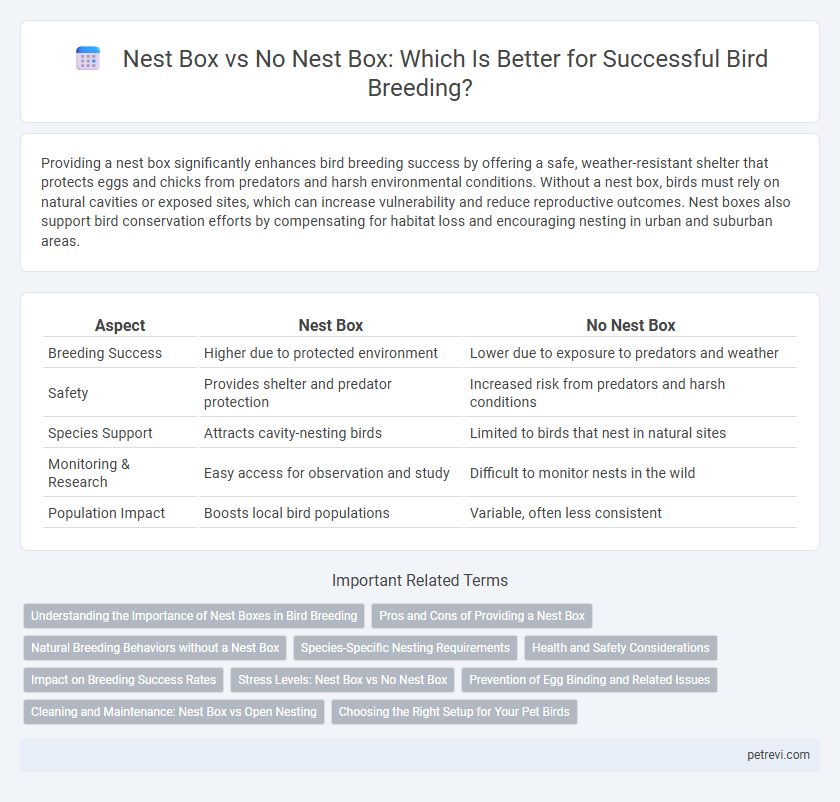Providing a nest box significantly enhances bird breeding success by offering a safe, weather-resistant shelter that protects eggs and chicks from predators and harsh environmental conditions. Without a nest box, birds must rely on natural cavities or exposed sites, which can increase vulnerability and reduce reproductive outcomes. Nest boxes also support bird conservation efforts by compensating for habitat loss and encouraging nesting in urban and suburban areas.
Table of Comparison
| Aspect | Nest Box | No Nest Box |
|---|---|---|
| Breeding Success | Higher due to protected environment | Lower due to exposure to predators and weather |
| Safety | Provides shelter and predator protection | Increased risk from predators and harsh conditions |
| Species Support | Attracts cavity-nesting birds | Limited to birds that nest in natural sites |
| Monitoring & Research | Easy access for observation and study | Difficult to monitor nests in the wild |
| Population Impact | Boosts local bird populations | Variable, often less consistent |
Understanding the Importance of Nest Boxes in Bird Breeding
Nest boxes provide a safe and controlled environment that significantly increases breeding success rates for cavity-nesting bird species by protecting eggs and chicks from predators and harsh weather. Birds without access to nest boxes often struggle to find secure sites, leading to reduced hatching rates and lower fledgling survival. Installing nest boxes tailored to specific bird species supports population stability and biodiversity by enhancing reproductive outcomes.
Pros and Cons of Providing a Nest Box
Providing a nest box for bird breeding offers a safe, controlled environment that enhances reproductive success by protecting eggs and chicks from predators and harsh weather. However, nest boxes can also attract unwanted species, require regular maintenance to prevent disease, and may lead to dependency, reducing natural nesting behaviors. Without a nest box, birds rely on natural cavities which promote biodiversity but often result in lower breeding success due to exposure and competition for limited natural sites.
Natural Breeding Behaviors without a Nest Box
Natural breeding behaviors in birds without a nest box involve selecting diverse locations such as tree branches, ground vegetation, or cavities in natural habitats, which provide varying levels of protection and nesting material availability. Birds exhibit species-specific strategies like scraping ground nests or building woven nests in shrubs, relying heavily on environmental cues and predator avoidance for successful reproduction. These behaviors enhance adaptability and ecological balance but often result in lower nest success rates compared to managed nest box environments.
Species-Specific Nesting Requirements
Providing a nest box tailored to species-specific nesting requirements significantly increases breeding success by mimicking natural habitats and offering protection from predators and harsh weather. Certain cavity-nesting birds, such as bluebirds and chickadees, rely heavily on nest boxes due to scarcity of natural tree cavities in urban or deforested areas. Without nest boxes, these species may experience reduced breeding opportunities, lower clutch sizes, and higher vulnerability to environmental stresses, highlighting the importance of targeted conservation efforts.
Health and Safety Considerations
Nest boxes provide birds with a secure and sheltered environment that reduces exposure to predators and harsh weather, significantly improving chick survival rates and overall breeding success. Without nest boxes, birds are more vulnerable to environmental hazards and parasitic infestations, which can negatively impact their health and the development of their offspring. Properly designed nest boxes also facilitate easier monitoring and maintenance, promoting healthier conditions and reducing the risk of disease transmission.
Impact on Breeding Success Rates
Providing nest boxes significantly increases breeding success rates in bird populations by offering safe, predator-resistant sites that mimic natural cavities. Studies show species using nest boxes experience higher fledgling survival and increased clutch sizes compared to those without access to artificial nesting sites. Absence of nest boxes often leads to lower breeding success due to scarce suitable nesting habitats and increased predation risks.
Stress Levels: Nest Box vs No Nest Box
Birds breeding in environments with nest boxes experience significantly lower stress levels compared to those without, as nest boxes provide a safe, sheltered space that reduces exposure to predators and harsh weather conditions. Studies reveal that corticosterone levels, an indicator of stress, are markedly higher in birds forced to nest in open or natural cavities lacking the protection of a nest box. Providing nest boxes enhances reproductive success and overall bird welfare by creating a controlled, secure habitat that mitigates environmental stressors during breeding.
Prevention of Egg Binding and Related Issues
Nest boxes provide a safe and stable environment that reduces stress for breeding birds, significantly lowering the risk of egg binding and related complications. Birds with access to properly designed nest boxes experience improved egg-laying conditions, which promote smoother oviposition and decrease the likelihood of retained eggs. Lack of nest boxes often leads to unstable nesting sites, increasing stress and consequently the incidence of egg binding, impacting bird health and reproductive success.
Cleaning and Maintenance: Nest Box vs Open Nesting
Nest boxes provide a controlled environment that simplifies cleaning and maintenance, reducing parasite infestations and promoting healthier bird breeding conditions compared to open nesting sites. Regular removal of old nesting material from nest boxes prevents buildup of pathogens, while open nests are harder to monitor and clean, increasing risks for both adults and chicks. Properly maintained nest boxes can significantly improve breeding success rates by minimizing disease and enhancing hygiene.
Choosing the Right Setup for Your Pet Birds
Choosing the right setup for your pet birds significantly impacts breeding success, with nest boxes providing a controlled, secure environment that mimics natural nesting sites, encouraging mating and egg-laying behaviors. Without a nest box, birds may exhibit stress or fail to breed, as they lack a defined space for nesting, which is critical for species like budgerigars, canaries, and finches. Optimal nest box placement, size, and material tailored to the bird species ensure healthier offspring and improved breeding results.
Nest box vs No nest box for Bird breeding Infographic

 petrevi.com
petrevi.com